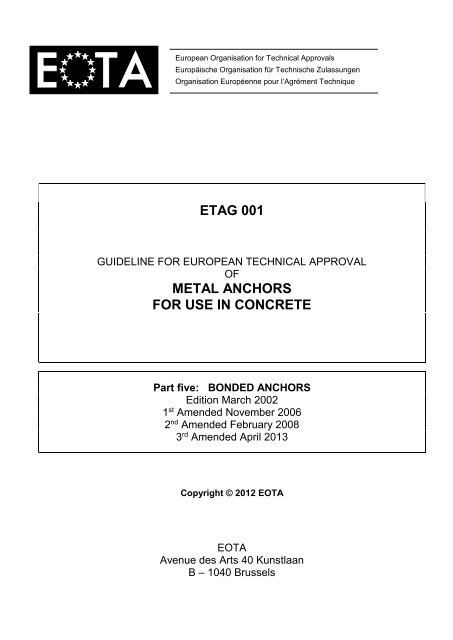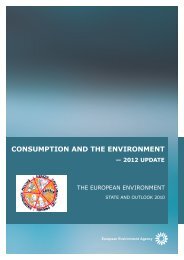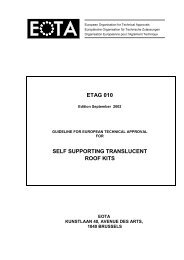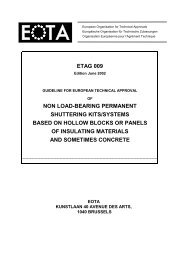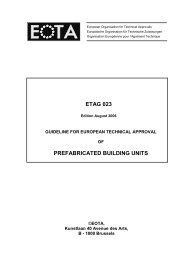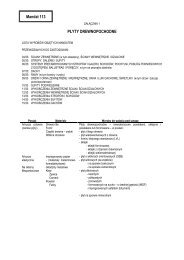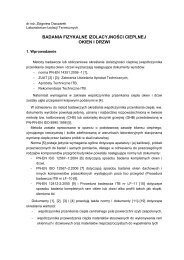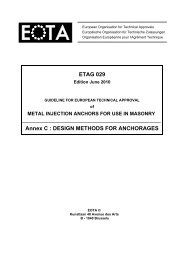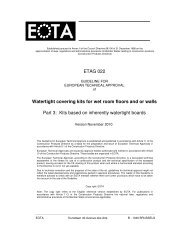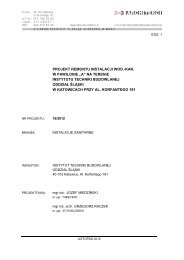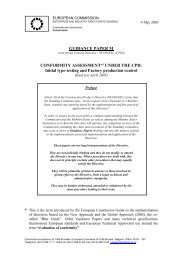ETAG 001
ETAG 001
ETAG 001
You also want an ePaper? Increase the reach of your titles
YUMPU automatically turns print PDFs into web optimized ePapers that Google loves.
- Torque-controlled bonded anchor: placed into a cylindrical hole, the load transfer is a combination ofbonding and expansion, where the expansion is achieved by a specialrod.- Post-installed rebar connections: straight ribbed reinforced bar placed into a cylindrical hole. The postinstalled rebar connections are designed according to Eurocode 2 andETA based on TR 023.The test programme for "Torque-controlled bonded anchor" is specified in Technical Report TR 018 and the testprogramme for "Post-installed rebar connections" is specified in Technical Report TR 023 to this Part of <strong>ETAG</strong>.a) capsule typeb) injection type<strong>ETAG</strong> <strong>001</strong>-5- 4 -
c) bulk typeFigure 2.2Examples of installation techniques (bonded anchors)The following default values for the minimum embedment depth shall be used:d ≤ 10mm hef = 60 mm12mm hef = 70 mm16mm hef = 80 mm20mm hef = 90 mm≥ 24mm hef = 4dLower values of minimum embedment depth are possible only if 20 tests at least be carried out with quadrupleanchor groups according to <strong>ETAG</strong> <strong>001</strong>, Annex A, 5.2.2. These 20 tests could be made with each 5 tests with thesmallest 4 sizes; the requirements of <strong>ETAG</strong> <strong>001</strong> Part 1, 6.1.2.2.3 have to be fulfilled for all anchor sizes.The embedment depths in the ETA may not be less than the minimum values 40 mm and 4d.2.1.2 MaterialsThe bonding materials may be manufactured from synthetic mortar, cementitious mortar or a mixture of the twoincluding fillers and/or additives.The packaging systems may be glass capsule, soft-skin capsule, cartridge or bulk.The embedded parts of the anchor may be threaded rod, deformed reinforcing bar, internally threaded socket orother shapes.If embedded parts are commercial standard rods supplied by another party as the approval holder (e.g.manufacturer of standard rods), then the following conditions have to be fulfilled:- Material, dimensions and mechanical properties of the metal parts according to the specifications given inan Annex of the ETA- Confirmation of material and mechanical properties of the metal part by inspection certificate 3.1according to EN 10204: 2004; the documents shall be stored.- Marking of the rod with the envisage embedment depth. This may be done by the manufacturer of the rodor the person on job site.2.2 Concrete2.2.2 Concrete membersPart 5 applies to applications where the minimum thickness of members in which anchors are installed ish > 100 mm.The minimum member thickness depends on application parameters and it is given by:h = hef + h 100 mmThe values given for h under (a) and (b) are valid for holes drilled with electrical hammer drilling machines anddiamond drilling. For compressed air drilling these values shall be evaluated by tests.<strong>ETAG</strong> <strong>001</strong>-5- 5 -
- submit a written declaration to the Approval Body stating whether or not and in which concentration theproduct and/or constituents of the product contains substances which have to be classified as dangerousaccording to Directive 67/548/EEC and Regulation (EC) No 1272/2008 and listed in the "Indicative list ondangerous substances" of the EGDS - taking into account the installation conditions of the constructionproduct and the release scenarios resulting from there.The use of recycled materials shall always be indicated, because this could lead to the implementation of furtherassessment and verification methods.The information concerning the presence of dangerous substances listed in Council Directive 67/548/EEC andRegulation (EC) No 1272/2008 regulated at European level and listed in the "Indicative list on dangeroussubstances" of the EGDS (Expert Group on Dangerous Substances of the EU Commission) and/or of otherdangerous substances, shall be circulated as part of the evaluation report by the issuing Approval Body to theother Approval Bodies, under strict conditions of confidentiality.5 METHODS OF VERIFICATION5.0 GeneralIn this section two test methods are distinguished: unconfined tests (see Figure 5.1) and confined tests(see figure 5.2). Unconfined tests allow an unrestricted formation of the rupture concrete cone. They areperformed according (see figure 5.1) to Annex A, 4. In confined tests concrete cone failure is eliminated bytransferring the reaction force close to the anchor into the concrete.load cellload cylindersupportdisplacement transducersocketconcrete test memberBonded Anchor 2 h ef 2 h efFigure 5.1Example of a tension test rig for unconfined tests<strong>ETAG</strong> <strong>001</strong>-5- 8 -
the influencing factors the failure mode may change (e.g. tests with “concrete cone failure” at 20° C and“combined pull-out and concrete cone failure” at 80° C show lower performance at 80° C). If the tests areperformed in such a way that “combined pull-out and concrete cone failure” is observed (e.g. at 20° C and 80° C)the largest difference in performance is observed. This influencing factor is decisive for the evaluation of abonded anchor system.So the main aim of the test regime is to establish a resistance for “combined pull-out and concrete cone failure” -if required, modified by the influencing factors-, which is published as Rk in the ETA. The characteristic bondresistance allows a design of bonded anchors for “combined pull-out and concrete cone” resistance at variableembedment depth with or without group- or edge effects. The resistance for “concrete cone” and “steel failure”can be calculated according to current experience.To avoid “steel failure” in the tests embedded parts of a higher strength than specified by the manufacturer andpublished in the ETA may be used as long as the functioning of the anchor is not influenced. This condition isfulfilled if the geometry of the embedded part of higher strength steel is identical with the specified embeddedpart.In cases where the use of high strength anchor elements (steel strength ≥ 10.9) is insufficient to prevent “steelfailure” the anchor embedment depth shall be reduced. This principle may overrule the required embedmentdepth for the suitability tests (5.1.2) and admissible service condition tests (5.1.3).Special conditions for tests according to line 1 of Table 5.1 or 5.2 are given in 5.1.2.The unconfined tests with minimum specified embedment depth in the admissible service condition tests mayshow “concrete cone failure”. If these results are used for evaluating the characteristic bond resistance(eventually modified by the various influencing factors) the approach is conservative. More precise results maybe achieved if the minimum embedment depth is chosen in a way that bond failure (“combined p ull-out andconcrete cone failure”) is decisive.Bonded anchors with a high bond resistance may show only “concrete cone failure” or “steel failure” inunconfined tests. In this case it is recommended to perform all tests as confined tests and to evaluate Rk takingthe modification factor αsetup into account (see Equation 6.17.1).For the assessment of a bonded anchor the overall test programme has to be carried out including at least thefollowing minimum number of different concrete batches within the programme of testing:Assessment for C20/25:Assessment for C50/60:on at least 3 different batches, if the concrete comes from differentconcrete supplierson at least 4 different batches, if the concrete comes from the sameconcrete supplieron at least 2 different batches, if the concrete comes from the same or fromdifferent concrete suppliers.If concrete batches come from the same concrete supplier it shall be ensured that each batch is made from adifferent delivery of either cement or aggregates.Reference Tension Tests (R) shall be performed because they are needed for the evaluation of the results of thesuitability tests and to take account of the influence of certain parameters on the tension load resistance ofbonded anchors. They shall be made in each batch. All reference tests shall be carried out as follows: in dry concrete at normal ambient temperature (T = + 21° C + 3 °C)anchor installation in accordance with the manufacturer’s published instructionsas confined test; they shall be made at approximately the same curing time as the correspondingsuitability tests or tests for admissible service condition.In general, the reference tests shall be made in the same concrete batch as the tests to which they shall becompared (for exception, see note (6) in Table 5.1 and note (4) in Table 5.2). The reference tests shall be madein non-cracked concrete (cracked concrete, w = 0,3mm), if their results shall be compared with results of testsin non-cracked concrete (cracked concrete).It is necessary to carry out at least 5 reference tests in each series. If the coefficient of variation of the failureloads is > 15 %, then the number of reference tests shall be increased.<strong>ETAG</strong> <strong>001</strong>-5- 10 -
If the manufacturer applies for embedded parts of bonded anchors which are geometrically identical but ofdifferent material, then all tests shall be made with one material. For the other material, only the torque testsaccording to Part 1, Table 5.1 or 5.2, line 7 shall be carried out and if the embedded part has a reduced sectionalong the length shear tests according to Part 1, Table 5.4, line 5 and 6 or line 7 and 8 for the evaluation of thecharacteristic shear resistance are necessary.If the approval is to cover more than one drilling technique, then all tests shall be done with all drillingtechniques.5.1.2 Tests for suitabilityThe types of tests, test conditions, the number of required tests and the criteria applied to the results are given inTable 5.1 (anchors for use in cracked and non-cracked concrete) and Table 5.2 (anchors for use in non-crackedconcrete only). Detailed information about special tests are given in the chapters after the Tables.In all suitability tests, the hole shall be drilled with a drill bit dcut,m. In general a torque shall not be applied to theanchor. Only in torque tests are the anchors torqued to failure.The suitability tests shall be performed with the depth requested by the manufacturer. If the manufacturerapplies for bonded anchors with several embedment depths, the installation safety tests according to line 1,Table 5.1 or 5.2 shall be done with the maximum embedment depth requested by the manufacturer, the othersuitability tests with the medium value between the minimum and maximum requested embedment depth.To avoid steel failure in the installation safety tests with maximum embedment depth, as an example thefollowing test procedure may be employed:Use a test member consisting of two concrete blocks which are stacked on the top of each other withoutpermanent connection. The drilling and cleaning of the hole as well as the injection of the hole for anchors withthe maximum embedment depth is done in the two parts. After that remove the upper concrete block, set theanchor in the bottom block and after curing carry out the tension test.<strong>ETAG</strong> <strong>001</strong>-5- 11 -
Table 5.1 Suitability tests for bonded anchors to be used in cracked and non-cracked concrete (10)Purpose of test Concrete Crackwidthw(mm)1Installation safety -(a) dry concrete C20/25 0 5R(b) wet concrete C20/25 0 5R(c) flooded hole C20/25 0 5installationR(d) mixingC20/25 0 -technique-3 Functioning in low C20/25 0,5 5strength concreteR4 Functioning in high C50/60 0,5 5strength concreteR5 Functioning in crackmovements6 Functioning undersustained loads7 Maximum torquemoment8 Functioning underfreeze/thaw cond.9 Functioning withInstallation directionNotes to Table 5.1C20/25 0,1 -0,3Minimumnumber oftests foranchor size(1)s i m i l load/disbehav.5R------------5-5 -R -5 -R -5 -R -5 -R -5 -R -5 -R -5 5R -5R5R5R--5R5R5R6.1.1.1(a) to (c)6.1.1.1and Part 16.1.1.2 (a)6.1.1.1(a)to (c), (e)Criteriareq. (2)C20/25 0 - - 5 - -- - R - -C50/60 0 5 5 5 5 5 Part 1,6.1.1.2 (d)C50/60 0 --C20/25 0 ------5R--------5R6.1.1.1(a)to (c), (f)6.1.1.1(a) to (c)(1) Anchor size: s = smallest; i = intermediate; m = medium; l = largestm = M12 or smallest size if that is larger than M12.(2) see section 6.1.1.1 (d).(3) These suitability tests shall be performed as confined tests.Rem.suit.testsTestproced.suit.testsRemarksRef. testR (5)> 0,8(8) (3) 5.1.2.1(a) C20/25> 0,75(8) (3) 5.1.2.1(b) C20/25> 0,75(8) (3) 5.1.2.1(c) C20/25> 0,8(8) (3) 5.1.2.1(d) C20/25> 0,8 (3) 5.1.2.2 w = 0,3C20/25>0,8 (3) 5.1.2.2 w = 0,3or >1,0C50/60(6)> 0,9 (4) 5.1.2.3 w = 0,3(7)C20/25(7)> 0,9 (3) 5.1.2.5C20/25- 5.1.2.6 -> 0,9 (3) 5.1.2.7> 0,9 (3)(9)5.1.2.8C50/60C20/25(4) The test “functioning in crack movements“ shall be carried out as unconfined test (Annex A, 5.5).The following tension tests to failure shall be carried out as confined tests.(5) R: The reference tests shall be carried out with the same anchor diameter and in the same slab orsame concrete batch as in the corresponding suitability tests.(6) For Options 1, 3 and 5 (different characteristic values for C20/25 and C50/60) the correspondingreference tests shall be carried out in a crack width of 0,3mm. The required -factor shall be > 0,8. ForOptions 2, 4 and 6, reference tests (for line 3) will not be required, because in these options thecharacteristic resistance is independent of the concrete strength, therefore the results of the suitabilitytests will be compared with the results of reference tests carried out in low strength concrete (w = 0,3mm, line 2), the required -factor shall be > 1,0(7) The corresponding reference tests for the tension tests after the crack movements tests are requiredonly for smallest, medium and largest sizes. They shall be carried out with w = 0,3 mm. The results ofthe reference tests for intermediate sizes shall be derived from results of reference tests with the otherdiameters by using the mean bond strength of the neighbouring sizes.(8) For 2 = 1,2. For other partial safety factors, see Table 6.1 in 6.1.2.2.2.(9) The tests shall be performed with largest diameter applied for installation direction(10) This Table is not valid for bonded anchor systems if expansion forces by the anchor are created; thesetorque-controlled bonded anchors have to be assessed according to the Technical Report 018.<strong>ETAG</strong> <strong>001</strong>-5- 12 -
Table 5.2Suitability tests for bonded anchors to be used in non-cracked concrete onlyPurpose of test Concrete Crackwidthw(mm)1Installation safety -(a) dry concrete C20/25 0 5R(b) wet concrete C20/25 0 5R(c) flooded hole C20/25 0 5installationR(d) mixingC20/25 0 -technique-4 Functioning in high C50/60 0 5strength concrete-5 Functioning underrepeated loads6 Functioning undersustained loads7 Maximum torquemoment8 Functioning underfreeze/thaw cond.9 Functioning withInstallation directionNotes to Table 5.2C20/25 0 --Minimumnumber oftests foranchor size(1)s i m i l load/dis.beh.------------5 -R -5 -R -5 -R -5 -R -5 -- -5 -R -5R5R5R--5---6.1.1.1(a) to (c)6.1.1.1and Part 16.1.1.2 (b)6.1.1.1(a)to (c), (e)Criteriareq. (2)C20/25 0 - - 5 - -- - R - -C50/60 0 5 5 5 5 5 Part 1,6.1.1.2 (d)C50/60 0 --C20/25 0 ------5R--------5R6.1.1.1(a)to (c), (f)6.1.1.1(a) to (c)(1) Anchor size: s = smallest; i = intermediate; m = medium; l = largestm = M12 or smallest size if that is larger than M12.(2) see section 6.1.1.1 (d).(3) These suitability tests are performed as confined tests.Rem.suit.testsTestProcedur.Suit.TestsRemarksRef. testR (5)> 0,8(8) (3) 5.1.2.1(a) C20/25> 0,75(8) (3) 5.1.2.1(b) C20/25> 0,75(8) (3) 5.1.2.1(c) C20/25> 0,8(8) (3) 5.1.2.1(d) C20/25> 1,0 (3) 5.1.2.2 -(4)> 1,0 (3) 5.1.2.4C20/25>0,9 (3) 5.1.2.5- 5.1.2.6> 0,9 (3) 5.1.2.7> 0,9 (3)(9)5.1.2.8C20/25C50/60C20/25(4) Suitability tests for functioning in non-cracked high strength concrete (line 3) will only be required forOptions 8, 10 and 12. In these options the characteristic resistance is independent of the concretestrength, therefore the results of the suitability tests in high strength concrete shall be compared with theresults of the reference tests in low strength concrete. The required -factor shall be > 1,0For Options 7, 9 and 11 suitability tests in high strength concrete are not needed, because the anchorbehaviour in high strength concrete is checked in tests for admissible service conditions.(5) R: The reference tests shall be carried out with same anchor diameter and in the same slab or sameconcrete batch as in the corresponding suitability tests.(8) For 2 = 1,2. For other partial safety factors, see Table 6.1 in 6.1.2.2.2.(9) The tests shall be performed with largest diameter applied for installation direction<strong>ETAG</strong> <strong>001</strong>-5- 13 -
5.1.2.1 Installation safety testsConfined tension tests in non-cracked concrete C20/25.The following test conditions are defined for drilling the hole with an electric hammer drilling machine. In generalthe conditions are also valid for other drilling techniques. However some modifications of the installation safetytests might be necessary which shall be agreed by the Approval Bodies.5.1.2.1 (a) Effect of hole cleaning technique in dry substrateTests in dry concrete.Drill downwards to the depth defined by the manufacturer.Clean the hole with the hand pump and brush supplied by the manufacturer, using two blowing and one brushingoperation in the order prescribed in the manufacturer's installation instructions. This test procedure is valid only ifthe manufacturer’s installation instructions specify hole cleaning with at least four blowing and two brushingoperations. If the instructions specify less than this, then the above requirement (2 blows + 1 brush) shall bereduced proportionately and the number of blows/ brushes shall be lowered to the next whole number. Thereforewhere the manufacturer’s installation instructions recommend two blowing and one brushing operations, thesuitability tests shall be carried out without the brushing operation.If precise instructions for hole cleaning are not provided by the manufacturer's installation instructions, then thetests are carried out without hole cleaning.Install the embedded part in accordance with the manufacturer's installation instructions.5.1.2.1 (b) Effect of hole cleaning technique in wet substrateHole cleaning and installation according to 5.1.2.1 (a). However the concrete in the area of anchorage shall bewater saturated when the hole is drilled, cleaned and the embedded part is installed.The following procedure may be applied to ensure a water saturated concrete in the area of the anchorage:1. A hole with approximately 0,5 d0 (d0 = drill hole diameter of the tested anchor) is drilled in the concretesubstrate to the recommended depth ,2. The hole is filled with water and remains flooded for 8 days until water has percolated into the concrete at adistance equal to 1,5d to 2d from the axis of the hole,3. Water is sucked out of the hole,4. The final hole is drilled at the recommended diameter d0,Clean the hole according to the description for dry concrete (5.1.2.1(a)) and install the embedded part inaccordance with the manufacturer's installation instructions.If methods other than those described above are used it shall be shown by appropriate methods that theconcrete in the area of the anchorage is water saturated.5.1.2.1 (c) Effect of hole cleaning technique in flooded holeThe tests are made in concrete which is water saturated in the area of the anchorage. To ensure a watersaturated concrete in the area of the anchorage the procedure of 5.1.2.1(b) shall be applied. After cleaning thehole according to 5.1.2.1(a), fill the hole with water. Without removing water from the hole, place the bondingmaterial and insert the embedded part as described in the manufacturer’s installation instructions.These tests are not required for anchors where the manufacturer’s installation instructions state that water shallbe completely removed before anchor installation. Installation instructions shall make it clear that simply insertinga capsule or injecting bonding material does not adequately remove water, and a proper process shall bedescribed to remove water completely.5.1.2.1 (d) Effect of mixing techniqueTests are only required for those anchor types where the mixing technique is controlled by the installer, suchtechniques include:a) mixing components until a colour change is affected throughout the materialb) mixing with recommended equipment for a specified timec) carrying out a repetitive mixing operation for a specified number of times.<strong>ETAG</strong> <strong>001</strong>-5- 14 -
Tests shall be carried out on incomplete mixes, i.e. by reducing the specified process by 25 %.For example, in the case of a), the test is carried out after mixing for 75 % of the time taken to achieve an evencolour throughout the material.Tests are not required for capsule type bonded anchors, because the effect of mixing on the anchor behaviour isalready covered by the other suitability tests.5.1.2.1 (e) Effect of hole drilling tolerancesFrom experience, tolerances of drill bits for cylindrical holes do not adversely affect the performance of bondedanchors, therefore tests are not required.5.1.2.1 (f) Effect of variation in volume of bonding materialTests are not required.5.1.2.2 Functioning in low (C20/25) or high strength concrete (C50/60)The tests shall be carried out according to Annex A, however as confined tests.5.1.2.3 Functioning in crack movementsThe tests shall be carried out according to Annex A, 5.5, however the constant tension load Npcalculated from Equation (5.4).shall beNp =0.75 McN Rk,p1 12 13 4(5.4)NRk,p = characteristic resistance for pullout failure given in the ETA for cracked concrete C20/25Mc = partial safety factor given in the ETA2 = ratio according to Equation (6.15), tests at maximum long term temperature 1,03 = ratio according to Equation (6.16), tests at maximum short term temperature 1,04 = ratio according to Equation (6.22), tests for checking durability of adhesive 1,0The tension test after crack movements shall be done as a confined test.5.1.2.4 Functioning under repeated loadsThe tests shall be carried out in non-cracked concrete C20/25 according to Annex A, 5.6, however as confinedtests. The maximum load Nmax on the anchor shall be calculated by Equation (5.5).1.1 N Rk,p 1Nmax =Mc 12 13 4(5.5)NRk,p = characteristic resistance for pullout failure given in the ETA for non-cracked concreteC20/25Mc = partial safety factor given in the ETA2 = ratio according to Equation (6.15), tests at maximum long term temperature 1,03 = ratio according to Equation (6.16), tests at maximum short term temperature 1,04 = ratio according to Equation (6.22), tests for checking durability of adhesive 1,0<strong>ETAG</strong> <strong>001</strong>-5- 15 -
5.1.2.5 Functioning under sustained loadsTests shall be carried out in non-cracked concrete C20/25, both at normal ambient temperature and maximumlong term temperature.(a) Tests at normal ambient temperatureInstall anchors at normal ambient temperature.Load anchor to Nsust according to Equation (5.6a):Nsust =1.1 N Rk,pMc1 12 13 4(5.6a)NRk,p = characteristic resistance for pullout failure given in the ETA for non-cracked concreteC20/25Mc = partial safety factor given in the ETA2 = ratio according to Equation (6.15), tests at maximum long term temperature 1,03 = ratio according to Equation (6.16), tests at maximum short term temperature 1,04 = ratio according to Equation (6.22), tests for checking durability of adhesive 1,0Maintain load at Nsust and maintain temperature at normal ambient temperature and measure the displacementsuntil they appear to have stabilised, but at least for three months (in special justified cases the Approval Bodymay allow a shorter duration for the sustained load test). Temperatures in the room may vary by + 3K due today/night and seasonal effects but the required test room temperature shall be achieved as an mean over thetest period. The frequency of monitoring displacements shall be chosen so as to demonstrate the characteristicsof the anchor. As displacements are greatest in the early stages, the frequency shall be high initially and reducedwith time. As an example, the following regime would be acceptable:During first hour: every 10 minutesDuring next 6 hours: every hourDuring next 10 days: every dayFrom then on: every 5-10 days.To check the remaining load capacity after the sustained load test, unload the anchor and carry out a confinedtension test.(b) Test at maximum long term temperatureThese tests are not needed for temperature range (a), see 4.1.1.2 (-40 °C to +40 °C), because the effect of themaximum long term temperature (+24 °C) is tested under normal ambient temperature.It is recommended to perform the tests in concrete specimen made from the same batch as the specimen usedfor the tests according to 5.1.3.1(a).Install anchors at normal ambient temperature.Load anchor to Nsust according to Equation (5.6b):Nsust =1.1 N Rk,pMc1 13 4(5.6b)NRk,p = characteristic resistance for pullout failure given in the ETA for non-cracked concreteC20/25Mc = partial safety factor given in the ETA3 = ratio according to Equation (6.16), tests at maximum short term temperature 1,04 = ratio according to Equation (6.22), tests for checking durability of adhesive. 1,0Raise the temperature of the test chamber to the maximum long term temperature at a rate of approximately 20°C per hour.Maintain load Nsust and maintain temperature at the maximum long term temperature. For the duration of thetests, the allowed variation of the temperature of the test chamber and the frequency of monitoringdisplacements 5.1.2.5(a) applies.<strong>ETAG</strong> <strong>001</strong>-5- 16 -
To check the remaining load capacity after the sustained load test, unload the anchor and carry out a confinedtension test at the maximum long term temperature.5.1.2.6 Torque testsTests according to Annex A, 5.10.In addition, it has to be checked if the 95% of tension force generated in the torque tests at T = 1,3 Tinst is notlarger than the characteristic resistance for pullout failure NRk,p = · d · hef · Rk,ucrwithhef: min embedment depth for the corresponding diameterRk,ucr: characteristic bond resistance for non-cracked concrete C20/25 as given in the ETA.5.1.2.7 Functioning under freeze/thaw conditionsThe tests are performed in non-cracked freeze-thaw resistant concrete C50/60 in accordance with EN 206. Astest member in general a cube with side length of 200 mm to 300 mm or 15d to 25d shall be used, splitting ofconcrete shall be prevented.Cover the top surface of the test member with tap water to a depth of 12 mm, other exposed surfaces shall besealed to prevent evaporation of water.Load anchor to Nsust according to Equation (5.7):Nsust = N Rk,pMc f(5.7)NRk,p = characteristic resistance for pullout failure given in the ETA for non-cracked concrete C50/60Mc = partial safety factor given in the ETAf = partial safety factor for actions = 1,4Carry out 50 freeze/thaw cycles as follows:- Raise temperature of chamber to (+ 20 2) °C within 1 hour, maintain chamber temperature at (+ 20 2) °Cfor 7 hours.- Lower temperature of chamber to (-20 2) °C within 2 hours, maintain chamber temperature at (-20 2) °C for14 hours (total of 16 hours).If the test is interrupted, the samples shall always be stored at a temperature of (-20 2) °C between the cycles.The displacements shall be measured during the temperature cycles.After completion of 50 cycles carry out a confined tension test at normal ambient temperature.5.1.2.8 Effect of installation directionsThe effect of installation directions shall be shown by appropriate tests or investigations. If the conditions in6.1.1.2(g) are satisfied, then further tests are not required. However, for the critical overhead installation, it isnecessary to carry out tension tests, unless the manufacturer's installation instructions exclude overhead use.5.1.3 Tests for admissible service conditionsThe test conditions are given in Part 1, 5.1.3 and Annex B. They are summarised in Table 5.4 of Part 1. Table5.4 applies to anchors to be used in cracked and non-cracked concrete according to Option 1. In addition to Part1, 5.1.3 and Annex B, tests according to 5.1.3.1, 5.1.3.2 and 5.1.4 shall be carried out.The current experience for bonded anchors is valid only for anchors with an embedment depth in the range asgiven in 2.1.1.The tests shall be performed with the depth requested by the manufacturer. If the manufacturer applies forbonded anchors with several embedment depths, the tests for admissible service conditions shall be done asunconfined tests for all diameters with the minimum requested embedment depth.Table 5.5 and Table 5.6 show the required number of tests for determination of the admissible service conditionswhere the design model with characteristic bond resistance Rk according to the Technical Report 029 is used.<strong>ETAG</strong> <strong>001</strong>-5- 17 -
Table 5.5 is given for bonded anchors to be used in cracked and non-cracked concrete based on unconfinedtests. A1 - tests with intermediate anchor sizes may be omitted only if a continuous bond resistance is shownwith A1 tests as confined tests for all anchor sizes.Table 5.6 is given for bonded anchors to be used in cracked and non-cracked concrete based on confined testsand calculated with setup.Test series A3 and A4 may be omitted for anchors to be used in non-cracked concrete only.For all tests for determination of admissible service conditions for tension resistance, Reference tension tests(R) shall be carried out in the same slab or batch (see 5.1.1) with the medium anchor size (see note 1 in Tables5.1 and 5.2).The reference tests for cracked concrete shall be carried out in a crack width of 0,3 mm.Table 5.5Admissible service condition tests for bonded anchors to be used in cracked and non-crackedconcrete based on unconfined testPurpose of test Concrete Crackwidth w(mm)Minimum number of tests for anchor sizes i m i lA1 (1) Tension in noncrackedC20/25 0 5 - 5 - 5lowstrength concreteA1 conf 5 5 5 5 5A2 (1) Tension in noncrackedC50/60 0 5 - 5 - 5highstrength concreteA3 (1) Tension in cracked C20/25 0,3 mm 5 - 5 - 5low strengthconcreteA4 (1) Tension in cracked C50/60 0,3 mm 5 - 5 - 5high strengthconcreteA14 (1) Tension test in C20/25 0 5 - 5 - 5cornerA20 (1) Minimum spacing C20/25 0 5 - 5 - 5and edgedistancesNotes to Table 5.5(0) R-tests for batch factor not included in table(1) Anchor size: s = smallest; i = intermediate; m = medium; l = largestExample for threaded rods:A1 confined tests show continuous bond resistance for all sizes.The applicant demands approval for 3 sizes; test all sizes.The applicant demands approval for 5 sizes; test 3 sizes (see table).The applicant demands approval for 8 sizes; test 4 sizes.The applicant demands approval for 11 sizes; test 5 sizes.The sizes shall be equally distributed in the range of all sizes.<strong>ETAG</strong> <strong>001</strong>-5- 18 -
Table 5.6Admissible service condition tests for bonded anchors to be used in cracked and noncrackedconcrete based on confined test and calculated with setupAlternative to table 5.5Purpose of test Concrete Crack Minimum number of tests for anchor sizewidth w(mm)s i m i lA1 confA2 (1)confA3 (1)confA4 (1)confA14 (1)A20 (1)Notes to Table 5.6Tension in noncrackedlowstrength concreteTension in noncrackedhighstrength concreteTension in crackedlow strengthconcreteTension in crackedhigh strengthconcreteTension test incornerMinimum spacingand edgedistancesC20/25 0 5 5 5 5 5C50/60 0 5 - 5 - 5C20/25 0,3 mm 5 - 5 - 5C50/60 0,3 mm 5 - 5 - 5C20/25 0 5 - 5 - 5C20/25 0 5 - 5 - 5(0) R-tests for batch factor not included in table(1) Anchor size: s = smallest; i = intermediate; m = medium; l = largestExample for threaded rods:A1 confined tests show continuous bond resistance for all sizes.The applicant demands approval for 3 sizes; test all sizes.The applicant demands approval for 5 sizes; test 3 sizes (see table).The applicant demands approval for 8 sizes; test 4 sizes.The applicant demands approval for 11 sizes; test 5 sizes.The sizes shall be equally distributed in the range of all sizes.5.1.3.1 Influence of temperature on characteristic resistancesThe tests according to 5.1.3.1(a) to 5.1.3.1(c) shall be carried out in concrete from the same concrete batch.a) Effect of increased temperatureThe tests shall be carried out in non-cracked concrete C20/25 at the following temperatures for the differenttemperature ranges given in 4.1.1.2:Temperature range a) maximum short term temperature up to + 40 °C:Test are performed with the maximum short term temperature at + 40 °C. The maximum long term temperatureat approximately +24 °C is checked by the tests at normal ambient temperature.Temperature range b) maximum short term temperature up to + 80 °C:Test are performed with the maximum short term temperature at +80 °C and with the maximum long termtemperature at +50 °C.Temperature range c) on manufacturer's requestTest are performed with the maximum short term temperature and the maximum long term temperaturespecified by the manufacturer within the range of 0,6 times to 1,0 times the maximum short term temperatureand at temperatures between +21 °C and maximum short term temperature with an increment of 20 K.The tests are performed in non-cracked concrete C20/25. They may be carried out in slabs or, where space ofthe heating chamber is restricted, in cubes. Splitting of the concrete shall be prevented by means of confinement(dimensions, reinforcement or transverse pressure).<strong>ETAG</strong> <strong>001</strong>-5- 19 -
Anchor size: M12 (or smallest in range if smallest size is larger than M12).Test method:Install anchors at normal ambient temperature according to manufacturer's installation instructions.Raise test member temperature to required test temperature at a rate of approximately 20K per hour. Cure testmember at this temperature for 24 hours.While maintaining the temperature of the test member in the area of the embedded part at a distance of 1d fromthe concrete surface at + 2K of the required value, carry out confined tension test.Note: The check that the requirement on the temperature in the test member is fulfilled shall be doneonce and then the test procedure shall be kept constant.Number of tests: 5 tests per temperature.b) Effect of low installation temperatureThe tests are performed in non-cracked concrete C20/25. For test member dimensions, see 5.1.3.1a).Anchor size: M12 (or smallest in range if smallest size is larger than M12).Test method:Drill and clean hole according to manufacturer's installation instructions then cool test member to the lowestinstallation ambient temperature specified by the manufacturer, and the bonding material and embedded part tothe lowest anchor component installation temperature specified by the manufacturer. Install anchor, maintain thetemperature of the test member at the lowest installation ambient temperature for the curing time quoted by themanufacturer at that temperature.Carry out confined tension test at the end of the curing time while maintaining the temperature of the testmember in the area of the embedded part at a distance of 1d from the concrete surface at the specified lowestinstallation temperature 2K.Note: The same note as for the test method in 5.1.3.1a) applies.Number of tests: 5 testsc) Minimum curing time at normal ambient temperaturePerform confined tension tests at normal ambient temperature at the corresponding minimum curing timespecified by the manufacturers.Note: One series of the reference tests according to 5.1.3 may be made at minimum curing time.Number of tests: 5 tests5.1.3.2 Shelf lifeThe manufacturer shall provide evidence in support of the quoted shelf life, including storage conditions.5.1.4 Tests for checking durabilityPart 1, 5.1.4 applies. In addition, the durability of the bonding material shall be verified by slice tests. With slicetests, the sensitivity of installed anchors to different environmental exposures can be shown.Test specimen:The concrete compressive strength class shall be C20/25. The diameter or side length of the concrete specimenshall be equal to or exceed 150mm. The test specimen may be manufactured from cubes or cylinders or may becut from a larger slab. They can be cast; it is also allowed to diamond core concrete cylinders from slabs.One anchor (medium size M12 or smallest size if the smallest size is larger than M12) to be installed per cylinderor cube on the central axis in dry concrete, drill bit dcut,m, according to the manufacturer's installation instructions .The embedded part shall be made out of stainless steel.After curing of the adhesive according to manufacturer's instructions the concrete cylinders or cubes arecarefully sawn into 30mm thick slices with a diamond saw. The top slice shall be discarded.To gain sufficient information from the slice tests, at least 30 slices are necessary (10 slices for everyenvironmental exposure test and 10 slices for the comparison tests under normal climate conditions.<strong>ETAG</strong> <strong>001</strong>-5- 20 -
Storage of the test specimen under environmental exposure:The slices with adhesive anchors are subjected to water with high alkalinity and condensed water withsulphurous atmosphere. For comparison tests slices stored under normal climate conditions (dry / +21 °C 3 °C/ relative humidity 50 5%) for 2000 hours are necessary.High Alkalinity:The slices are stored under standard climate conditions in a container filled with an alkaline fluid (pH = 13.2). Allslices shall be completely covered for 2.000 hours. The alkaline fluid is produced by mixing water with KOH(potassium hydroxide) powder or tablets until the pH-value of 13.2 is reached. The alkalinity of pH = 13.2 shallbe kept as close as possible to 13.2 during the storage and not fall below a value of 13.0. Therefore the pHvaluehas to be checked and monitored in regular intervals (at least daily). The producing of alkaline fluid bymixing water with KOH (potassium hydroxide) powder or tablets could be given as an example. If other materialsare used then it has to be shown that same results and comparable assessment are achieved respectively.Sulphurous atmosphere:The tests in sulphurous atmosphere shall be performed according to EN ISO 6988:1994 "Metallic and other nonorganiccoatings – Sulphur dioxide test with general condensation of moisture". The slices are put into the testchamber, however in contrast to EN ISO 6988 the theoretical sulphur dioxide concentration shall be 0,67 % atbeginning of a cycle. This theoretical sulphur dioxide concentration corresponds to 2 dm 3 of SO2 for a testchamber volume of 300 dm 3 . At least 80 cycles shall be carried out.Slice tests:After the storage time, the thickness of the slices is measured and the metal segments of the bonded anchorsare pushed out of the slice, the slice is placed centrally to the hole of the steel rig plate. If slices are unreinforcedthen splitting may be prevented by confinement. Care shall be taken to ensure that the loading punch actscentrally on the anchor rod.The results of at least 10 tests shall be taken for every environmental exposure and for comparison; results withsplitting failure shall be ignored.5.3 Methods related to 4.3 (hygiene, health and the environment)5.3.1 Method of verificationThe product and/or constituents of the product listed in the EOTA TR 034: "General Checklist for<strong>ETAG</strong>s/CUAPs/ETAs -Content and/or release of dangerous substances in products/kits”, which have to beconsidered will be verified by the given methods taking into account the installation conditions of the constructionproduct and the release scenarios resulting from there. Regulations related to placing the product on the marketmay also need to be taken into account.Regarding the release scenarios referred to in the EOTA TR 034, the use category IA2 (Product with no directcontact to (e.g. covered products) but possible impact on indoor air) have to be considered.6 ASSESSING AND JUDGING THE FITNESS OF ANCHORS FOR AN INTENDED USE6.0(b)Conversion of ultimate loads to take account of concrete and steel strengthPart 1, 6.0(b) applies. However, for pullout failure (including pullout failure of single anchors with a typical shallowcone at the loaded end), a linear relationship between the failure loads in low and high strength concrete may beassumed for simplification.6.1 Assessing and judging related to 4.1 (mechanical resistance and stability)6.1.1 Suitability6.1.1.1 Criteria valid for all testsIn all tests according to lines 1 to 6 and 8 to 9 of Tables 5.1 and 5.2 the following criteria shall be met.(a)Instead of the requirement on the load-displacement curves in Part 1, 6.1.1.1 (a) with respect touncontrolled slip the following evaluation shall be done:<strong>ETAG</strong> <strong>001</strong>-5- 21 -
With bonded anchors uncontrolled slip occurs when the mortar with the embedded part is pulled out of thedrilled hole (because then the load displacement behaviour depends significantly on irregularities of thedrilled hole). The corresponding load when uncontrolled slip starts is called load at loss of adhesion Nu,adh.Nu,adh shall be evaluated for every test from the measured load displacement curve. In general the load atloss of adhesion is characterised by a significant change of stiffness, see Figure 6.1a). If the change instiffness at a defined load is not so obvious, e.g. the stiffness is smoothly decreasing, the load at loss ofadhesion shall be evaluated as follows:1) Compute the tangent to the load-displacement curve at a load 0,3 Nu (Nu = peak load in test). Ingeneral the tangent stiffness can be taken as the secant stiffness between the points 0/0 and0,3 Nu/0,3 (0,3 = displacement at N = 0,3 Nu).2) Divide the tangent stiffness with a factor of 1,5.3) Draw a line through the point 0/0 with the stiffness as calculated in 2).4) The point of intersection between this line and the measured load-displacement curve gives the loadNu,adh where the adhesion fails, see Figure 6.1b).If there is a peak in the load-displacement curve, to the left side of this line, which is higher than the load atintersection, Nu,adh is taken as the peak load, see Figure 6.1c).If there is a very stiff load-displacement curve at the beginning (0,3 0,05mm) the drawing of the line forthe calculation can be shifted to the point (0,3 Nu/0,3 ), see Figure 6.1d).For all suitability tests factor 1 shall be calculated according to Equation (6.12):1 =NNu, adhRk, pMc (6.12)4Nu,adh = load at loss of adhesion as defined aboveNRk,p = characteristic resistance for pullout failure given in the ETA for concrete strengthclass and state of concrete (cracked, non-cracked) corresponding to the evaluatedsuitability test.4 = 1,3Mc = partial safety factor given in the ETAThe minimum value of 1 of all suitability tests is decisive. If the value of 1 is less than 1,0 then thecharacteristic resistance NRk,p shall be reduced according to 6.1.2.2.1(b).The evaluation of the load at loss of adhesion is not required when failure occurs between mortar and embeddedpart along the entire embedment depth (see definition of uncontrolled slip). In this case the factor 1 shall betaken as 1,0.<strong>ETAG</strong> <strong>001</strong>-5- 22 -
a) load at loss of adhesion by a significant change of stiffness b) evaluation of load at loss of adhesionc) evaluation of load at loss of adhesion d) evaluation of load at loss of adhesionFigure 6.1Examples of load-displacement curves(b) The criteria of the scatter of the load/displacement curves given in Part 1, 6.1.1.1 (b) are valid.(c) In each test series, the coefficient of variation of the ultimate loads shall be smaller than v = 30 %.(d) Instead of Equation (6.2) of Part 1, 6.1.1.1(d) the following Equation shall be used for calculation of the value:t,i; u,5%r,i ; r,iu,m = min t,iu,mr,iu,m;t,iu,5%r,iu,5%(6.13) = mean (5% fractile) of bond resistance of the suitability tests carried out in slab i = mean (5% fractile) of bond resistance of the corresponding reference test carried outu,5%in the same slab i or same batchThe bond strength of each test is calculated according to Equation (6.17).<strong>ETAG</strong> <strong>001</strong>-5- 23 -
A comparison of the characteristic values in Equation (6.13) is not required, if the conditions in Part 1, 6.1.1.1(d)are fulfilled or if the coefficient of variation of the ultimate bond strength values are 15% in both test series.The results of the sustained load tests at maximum long term temperature according to 5.1.2.5(b) shall becompared with the results of the corresponding test at maximum long term temperature according to 5.1.3.1a).6.1.1.2 Additional criteria valid for specific tests(e) Sustained load testsThe displacements measured in the tests have to be extrapolated according to Equation (6.14) (Findleyapproach) to 50 years ( tests at normal ambient temperature), or 10 years (tests at maximum long termtemperature), respectively. The trend line according to Equation (6.14) may be constructed with data from notless than the last 20 days (minimum of 20 data points) of the sustained load test. The extrapolateddisplacements shall be less than the mean value of the displacements su,adh in the corresponding reference testsat normal ambient temperature or maximum long term temperature respectively. su,adh is the displacement atNu,adh (loss of adhesion).s(t) = so + a t b (6.14)so = initial displacement under the sustained load at t = 0 (measured directly afterapplying the sustained load)a, b = constants (tuning factors), evaluated by a regression analysis of the deformationsmeasured during the sustained load tests(f) Freeze/thaw testsThe rate of displacement increase shall reduce with increasing number of freeze/thaw cycles to a value almostequal to zero.(g) Effect of installation directionsWhen installed in accordance with the manufacturer’s installation instructions for the direction concerned, thegap between the anchor and the wall of the hole shall be completely filled with mortar and there shall be no lossof bonding material from the hole following anchor setting after cleaning the surface. The embedded part shallnot move significantly during curing time.For tests with overhead installation the conditions in 6.1.1.1a) to 6.1.1.1c) and 6.1.1.1d) with = 0,9 shall befulfilled.6.1.2 Admissible service conditions6.1.2.1 CriteriaCriteria valid for all tension tests(a) Instead of the requirements on the load/displacement curves in Part 1, 6.1.2.1(a) with respect to uncontrolledslip the factor 1 shall be calculated according to Equation (6.12). The minimum value of 1 of all tests isdecisive.If the value 1 is less than 1,0 then the characteristic resistance NRk,p shall be reduced according to 6.1.2.2.1(b).(b) The criteria on the load/displacement behaviour of Part 1, 6.1.2.1(b) apply.(c) In each test series, the coefficient of variation of the ultimate loads shall be smaller than v = 20 %.<strong>ETAG</strong> <strong>001</strong>-5- 24 -
Additional criteria valid for specific tests(d) Tests at maximum long term temperatureFrom the failure loads measured in the tests at maximum long term temperature the factor 2 shall be calculatedaccording to Equation (6.15).N ; Nmltmltu,mu,5%2 = min N Nmltu,mru,m;NNmltu,5%ru,5%(6.15)= mean (5% fractile of) failure loads of the tests at maximum long term temperature; = mean (5% fractile of) failure loads of corresponding reference tests performed at normalambient temperature.A comparison of the 5% fractile of failure loads in Equation (6.15) is not required, if the conditions in Part 1,6.1.1.1(d) are fulfilled or if the coefficient of variation of failure loads is 15% in both test series.If the value 2 is less than 1,0 then the characteristic resistance NRk,p shall be reduced according to 6.1.2.2.1(b).(e) Tests at maximum short term temperatureFrom the failure loads measured in the tests at maximum short term temperature the factor 3calculated according to Equation (6.16)shall be3 = min N 0,8 Nmst mstN u,m ; u,5% mltN ; mltu,mmstu,mmltu,m;N0,8 Nmstu,5%mltu,5%(6.16)N = mean (5% fractile of) failure loads of the tests at maximum short term temperatureN = mean (5% fractile of) failure loads of the tests at maximum long term temperature. Foru,5%temperature range a) according to 4.1.1.2 the results of tests at normal ambienttemperature may be taken.A comparison of the 5% fractile of failure loads in Equation (6.16) is not required, if the conditions in Part 1,6.1.1.1(d) are fulfilled or if the coefficient of variation of failure loads is 15% in both test series.If the value 3 is less than 1,0 then the characteristic resistance NRk,p shall be reduced according to 6.1.2.2.1(b).(f) Tests at minimum installation temperatureThe mean failure loads and the 5% fractile of failure loads measured in tests at the minimum installationtemperature and corresponding minimum curing time shall be at least equal to the corresponding valuesmeasured in tests at normal ambient temperature and corresponding minimum curing time. These requirementsapply also for the tests at other installation temperatures and corresponding minimum curing times.A comparison of the 5% fractile of failure loads is not required, if the conditions in Part 1, 6.1.1.1(d) are fulfilledor if the coefficient of variation of failure loads is 15% in both test series.If the condition is not fulfilled, then the minimum curing time at the minimum installation temperature shall beincreased and the tests at minimum installation temperature shall be repeated until the condition is fulfilled. Thisapplies also for the tests at other installation temperatures and corresponding minimum curing times.(g) Tests at normal ambient temperature and corresponding minimum curing timeThe mean failure loads and the 5% fractile of failure loads measured in tests at the normal ambient temperatureand corresponding minimum curing time shall be at least 0,9 times the values measured in reference tests with a"long curing time" in the tests for admissible service conditions. The "long curing time" is the maximum curingtime normally used in admissible service conditions tests (24 hours for resins, 14 days for cementious mortars).A comparison of the 5% fractile of failure loads is not required, if the conditions in Part 1, 6.1.1.1(d) are fulfilledor if the coefficient of variation of failure loads is 15% in both test series.<strong>ETAG</strong> <strong>001</strong>-5- 25 -
If this condition is not fulfilled, then the minimum curing time at normal ambient temperature shall be increasedand the corresponding tests shall be repeated or the characteristic resistance for pull out failure given in the ETAis reduced according to 6.1.2.2.1(b).6.1.2.2 Assessment of admissible service conditions6.1.2.2.1 Characteristic resistance of single anchor(a)GeneralPart 1, 6.1.2.2.1(a) applies. In addition, for evaluating the characteristic tension resistance NRk for concrete conefailure and pullout failure (N Rk,c = NRk,p) the following provisions given in Equations (6.17 to 6.20) are valid.However, for pullout failure (including pullout failure of single anchors with a typical shallow cone at the loadedend) a characteristic bond resistance Rk instead of a characteristic resistance NRk may be given in the ETA;therefore the Equations (6.17.1 and 6.20.1) are valid, Equation (6.18) is unchanged and Equation (6.19) is notrelevant.- From the results of the tension tests for admissible service conditions the bond strength of each test iscalculated according to Equation (6.17):iRu=whereiuN (C20 / 25) d hef(6.17)= bond strength of a tension test with diameter d in slab i or batch i(C20/25) = peak load of a tension test with diameter d in slab i or batch i converted toC20/25 according to 6.0(b).d = diameter of embedded parthef = embedment depth= setupiuN (C20 / 25) d hef(6.17.1)setup = 1,0 if service condition tests are performed as unconfined tests= 0,75 if service condition tests in non-cracked concrete are performed as confinedtests= 0,70 if service condition tests in cracked concrete are performed as confined tests- To take the influence of different concrete parameters on the failure load into account the bond strengthiRuvalues according to Equation (6.17) shall be converted by Equation (6.18) using the results ofreference tests:Ru =iRuminrRu,m,mr,iRu,m, m(6.18)Ru = bond strength at normal ambient temperaturei Ru = bond strength according to Equation (6.17)min r = minimum value of the mean bond resistances of all reference tests seriesRu, m, m(test for suitability and admissible service conditions with anchor diameter‘medium’)= mean bond resistance of reference test with anchor diameter ‘medium’carried out in the same slab i or same batch i as those used for the tension tests foradmissible service conditions.The converting to the minimum bond resistance according to Equation (6.18) (modification of i Ru) canbe omitted, if the coefficient of variation of the ultimate bond resistance of all results in the reference testseries with diameter medium is 15 %. Thereby the characteristic resistance of the bond strength of theadmissible service condition tests has to be determined with a coefficient of variation of 15 %.<strong>ETAG</strong> <strong>001</strong>-5- 26 -
- From the values Ru according to Equation (6.18) the characteristic bond strength resistance Rk shall beevaluated according to Part 1, 6.1.2.2.1. In general, a constant value Rk valid for all anchor diametersshall be assumed. If the test data show that the bond strengths vary in a regularly definable way (notrandomly) with respect to anchor diameter, then the values Rk may be evaluated as a continuousfunction of the anchor diameter. Also a function with no more than one extremum is possible if all testresults show this product behaviour; e.g. it does not come from the influence of the different concretebatches.- The characteristic tension resistance for concrete cone failure and pullout failure is calculated fromEquation (6.19) using the characteristic bond resistance Rk as described above:NRk,0 = Rk d hef (6.19)(b)Reduction of the characteristic tension resistanceThe characteristic tension resistance shall be reduced if certain requirements are not met as described in thefollowing:(1) Load/displacement behaviour, tension loadingIf the value of 1 calculated according Equation (6.12) for the suitability tests (6.1.1.1(a)) and for the admissibleservice condition tests (6.1.2.1(a)) is less than 1,0, then the characteristic resistance NRk,p = NRk,c shall bereduced according to Equation (6.20).(2) Crack movement tests, repeated load tests and sustained load tests and freeze/thaw testsIf in the crack movement tests, repeated and sustained load tests and freeze/thaw tests the requirements on theload/displacement behaviour are not fulfilled (see 6.1.1.1 and Part 1, 6.1.1.1) then the characteristic resistanceshall be reduced and the tests shall be repeated until the requirements are fulfilled. The minimum value of thecharacteristic resistances evaluated from the above tests is decisive.If for a certain anchor size the characteristic resistance calculated from the results of the crack movement testsaccording to Equation (5.4) is smaller than the value evaluated according to 6.1.2.2.1 then this value of NRk isdecisive for the diameter in question.If the characteristic resistance calculated from the results of the repeated load tests, sustained load tests andfreeze/thaw tests according to Equation (5.5), (5.6) or (5.7) is smaller than the value evaluated according to6.1.2.2.1 for the medium anchor diameter then the characteristic resistance NRk,p = NRk,c of all anchor diametersshall be reduced by the same ratio.(3) Ultimate load in suitability testsIf the value on the ultimate load in the suitability tests (see 6.1.1.1(d), Equation (6.13)) for the tests accordingto Table 5.1, line 1 to 6 and 8,9 or Table 5.2, line 1 to 6 and 8,9 respectively is less than the req. accordingto Table 5.1 or 5.2 respectively in one test series, then the characteristic tension resistance NRk,p = NRk,c shall bereduced according to Equation (6.20).(4) Ultimate load in the tests at increased temperatureIf the requirements on the ultimate loads in the test at increased temperature (see 6.1.2.1(d) and 6.1.2.1(e)) arenot fulfilled then the characteristic tension resistance for NRk,p = NRk,c shall be reduced according to Equation(6.20).The above approach assumes that a constant characteristic resistance NRk is used up to the maximum longterm temperature. On request of the manufacturer the influence of temperature on NRk may be given in the ETA.However, then the required test program and the evaluation of the test results shall be agreed on by theresponsible Approval Body.(5) Ultimate load in the durability testsIf the requirements on the ultimate loads in the tests according to 5.1.4 are not fulfilled (see 6.1.3, Equation(6.22)) then the characteristic tension resistance NRk,p = NRk,c shall be reduced according to Equation (6.20) orthe characteristic bond resistance 0 Rk shall be reduced according to Equation (6.20.1).<strong>ETAG</strong> <strong>001</strong>-5- 27 -
NRk = NRk,0 min(minreq. 1 ; min ) 2 3 4 (6.20)req. NRk = characteristic resistance as given in the ETANRk,0 = characteristic resistance according to Equation (6.19)min = minimum ratio of all suitability tests 1,0req . 1 min = minimum ratio all suitability and admissible service condition tests 1,0req. = value according to Equation (6.13) (criteria for suitability tests)req. = required value of according to Table 5.1 or 5.21 = value according to Eq. (6.12) (criteria according 6.1.1.1 (a) and 6.1.2.1 (a);load/displacement behaviour)2 = value according to Eq. (6.15) (tests at maximum long term temperature) 1,03 = value according to Eq. (6.16) (tests at maximum short term temperature) 1,04 = value according to Eq. (6.22) (tests for checking durability of adhesive) 1,0 Rk = 0 1Rk min(min ; min ) 2 3 4req. req. (6.20.1) 0 Rk = characteristic bond resistance evaluated according to 6.1.2.2.1(a) third dashRk = characteristic bond resistance as given in the ETAThe characteristic bond resistance shall be rounded as follows:Rkstep Rk[N/mm²] [N/mm²] e.g.≤ 10 0,5 4 / 4.5 / 5 / 5.5 …> 10, ≤ 20 1,0 12 / 13 / 14 / 15…> 20 2,0 26 / 28 / 30 / 32 …6.1.2.2.2 Partial safety factor 2 and 3The partial safety factor 2 is evaluated from the results of the suitability tests according to line1 of Table 5.1 orTable 5.2 respectively according to Table 6.1:Table 6.1 Values of req. in the installation safety tests for bonded anchorspartial safety factor 2req. for tests according to Table 5.1 or 5.2, respectivelylines 1(a) and 1(d)lines 1(b) and 1(c)1,0 0,95 0,91,2 0,8 0,751,4 0,7 0,65For a coefficient of variation of the ultimate loads in the suitability tests, 20% v 30 % an additional safetyfactor 3 shall be given in the ETA.3 = 1 + (v(%) - 20) 0,03 (6.21a)For a coefficient of variation of the ultimate loads in the tension tests for admissible service conditions, 15% v 20 % an additional safety factor 3 shall be given in the ETA3 = 1 + (v(%) - 15) 0,03 (6.21b)The maximum value 3 from Equation (6.21a) and (6.21b) is decisive.<strong>ETAG</strong> <strong>001</strong>-5- 28 -
6.1.2.2.8 Displacement behaviourIn general the displacements are evaluated according to Part 1, 6.1.2.2.8, only the displacements under shorttermand long-term loading (NO and VO) in non-cracked concrete are evaluated from the sustained load tests.6.1.3 Assessment of durabilityIn respect to corrosion, Part 1, 6.1.3 is valid for the metal parts of bonded anchors.When checking durability for conditions b) and c) (see 2.2.2), any exposure of the embedded parts at the remoteface of the concrete member shall be taken into account.In the slice tests according to 5.1.4 it shall be shown that the bond strength of the slices stored in an alkalineliquid and sulphurous atmosphere media is at least as high as that of the bond strength of the comparison testson slices stored under normal conditions. To show compliance with this requirement the factor 4 shall becalculated according to Equation (6.22).4 =min um(stored)um,dry(6.22)min um(stored)um,drycondition= minimum mean bond strength of the slices stored in different media= mean bond strength of the comparison tests on slices stored under normalThe factor 4 shall be 1,0 for the tests in alkaline fluid and 0,9 for the tests in sulphurous atmosphere. If thevalue 4 is less than the above required values then the characteristic resistance NRk,p shall be reducedaccording to 6.1.2.2.1(b).The bond strength in the slice tests shall be calculated according to Equation (6.23)u =Nu d hslNu = measured maximum loadd = diameter of the embedded parthsl = thickness of slice, measured values(6.23)6.3 Assessment related to ER36.3.1 Methods of assessing and judgingThe product and/or constituents of the product listed in the EOTA TR 034: "General Checklist for<strong>ETAG</strong>s/CUAPs/ETAs -Content and/or release of dangerous substances in products/kits”, which have to beconsidered will be verified by the given methods taking into account the installation conditions of the constructionproduct and the release scenarios resulting from there. Regulations related to placing the product on the marketmay also need to be taken into account.The content of cadmium contained in zinc coatings shall be declared by the applicant.Note (to be implemented in the ETA):For dangerous substances falling under the scope of the CPD for which- no assessment and verification methods are given (or cannot be found in TR 034) or- “no performance determined” is declared or- the chosen verification and assessment method does not comply with the regulatory requirement of aparticular Member Statethere might be the necessity for an additional assessment.<strong>ETAG</strong> <strong>001</strong>-5- 29 -
6.7 Identification of anchorsAll components of the materials shall be described in a chemically unambiguous way and be identified bystandard tests (e.g. fingerprinting tests). All component amounts shall be specified either by mass, volume orpercentage, with appropriate tolerances.In addition to the tests mentioned in Part 1, the following characteristics shall be specified where relevant inaccordance with ISO, European or national standards, together with any others as appropriate.1 Organic Bonding agentsResin, hardener and additives shall be identified by the following tests:- density- viscosity- ignition loss and ash content- conventional dry extract- grain size analysis- tensile strength- bending strength- compressive strength- open time- reactivity (gel or setting time) (this may be tested with a standardisedformulation, not necessarily that specified for the bonding anchor).In addition, the following tests are necessary:Resin and hardener cured by polyaddition mechanismEpoxies- epoxy index (equivalent)- amine equivalentPolyurethanes- hydroxyl equivalent- isocyanate equivalentResin and hardener cured by polymerisationUnsaturated polyester, vinylester (epoxymethacrylates) and vinylesterurethanes(urethanmethacrylates)- hardener (catalyst) content of peroxideMethylmethacrylates (MMA)- hardener, content of peroxideFiller- specification of filler material (e.g. tested by density) including type- specification of filler shape (e.g. fibre, balls, ...)- grain size analysis2 Inorganic bonding agents- material specification by chemical analysis- active binder batching- grain size analysis- density- dry extract- setting test- shrinkage and swelling test- bend and compressive strength at 7 and 28 days- ignition loss and ash contentFiller, additives- specification of filler material and additives- specification of filler shape<strong>ETAG</strong> <strong>001</strong>-5- 30 -
7 ASSUMPTIONS UNDER WHICH THE ETA IS TO BE ASSESSED7.1 Design methods for anchoragesFor the design method for anchorages with bonded anchors the design method A, B or C of Annex C accordingto Option chosen can be used.The current experience for bonded anchors is valid only for anchors with an embedment depth in the range asgiven in 2.1.1. For bonded anchors outside of this range the full test programme has to be carried out.The design model for the design of fastenings with bonded anchors using the characteristic bond resistance Rkis given in the Technical Report 029.The following chapter has to be considered if the design method with characteristic resistance NRk according toAnnex C is used.The current experience for spacing and edge distances for ensuring the characteristic resistance to tensionloads of a bonded anchor are:scr,N 2 hefccr,N 1 hefh 2 hefFor a thickness of concrete member h 2 hef splitting failure will not occur and a check for splitting failure is notnecessary.If the minimum member thickness is smaller than 2 hef the characteristic resistance of the anchor shall beevaluated from tests with single anchors at the corner and the member thickness chosen (Part 1,Table 5.4 line14). This characteristic resistance is valid for member thickness hmin h 2 hef .The following modifications in Annex C, 5.2.2 for the resistance to tension loads shall be taken into account:- Instead of the initial value of the characteristic resistance in case of concrete cone failure N°Rk,caccording to Annex C, Equation (5.2a) the characteristic resistance NRk determined fromEquation 6.20 (6.1.2.2.1(b)) shall be used.- The factor ucr,N (Annex C, 5.2.2.4 f) is to be established from corresponding tests. Alternatively thisvalue is taken ucr,N = 1,0 and different NRk for cracked and non-cracked concrete are used for N°Rk,c.The characteristic resistance for compression loading is equal to NRk,p7.2 Recommendations for packaging, transport and storageAny special transport conditions shall be stated on accompanying documents.Any special storage conditions shall be stated on packaging includingStorage temperature rangeRestrictions such as keeping away from heat and direct sunlightExpiry date.7.3 Installation of anchorsThe following requirements are in addition to those made in Part 1.The manufacturer's printed installation instruction shall be reported in the ETA. These installation instructionsshall be identical to the document used to established testing requirements for product assessment.Where pictograms are used their meaning shall be clear and unambiguous. If necessary, text in the appropriatelanguage shall be added to clarify the meaning.TerminologyThe precise meaning of all terms, such as installation ambient temperature, bonding material installationtemperature, open time, curing time, etc. shall be clear to the user.<strong>ETAG</strong> <strong>001</strong>-5- 31 -
Base material conditionAny limitations on the condition of base material shall be stated. For instance if anchors may not be installed incracked concrete or may not be installed in holes filled with water.Hole cleaningInstructions for hole cleaning shall specify in detail the type of cleaning equipment to be used, e.g. the volume ofblow out pump and diameter and material of brush, together with the precise cleaning procedure including thenumber and order of blowing/brushing actions.Temperature limitsThe following temperature limits shall be specified:Installation ambient temperature rangeBonding material installation temperature range.Operational time limitsOpen time and curing time shall be stated in relation to the relevant temperature limits, e.g.:Open time related to bonding material installation temperatureCuring time in relation to installation ambient temperatureIf tables are used to indicate times-versus-temperature ranges, they shall be inclusive so that the relevant time isclear for all temperatures within the appropriate range. An accepted example is given in the following:Installation ambientCuring timetemperature °C(minutes)e.g. 5 - 15 120 min16 - 25 60 minThe following example is not accepted:Installation ambientCuring timetemperature °C(minutes)5 120 min15 60 minWhen curing times are stated it shall be made clear that this is the earliest time that the anchor may be torquedor loaded. A longer waiting time may be recommended for proof of ultimate load tests on site, if so, this shall bestated.Where anchors are installed using adapters attached to the anchor rod or socket, then the precise time whensuch adapters may be removed shall be stated.Mixing instructionFor bulk components mixed by the operator it shall be stated that part mixing is not allowed and all componentsshall be mixed in the quantities as supplied.The mixing equipment, its maintenance and the mixing procedures shall be described in sufficient detail toensure thorough mixing as required. The point at which mixing is complete shall be clearly stated whether this bea mixing time or a mixed condition such as an even colour throughout the mix.Bonding material placement controlled by the installerFor systems where the volume of material is controlled by the installer, e.g. injection and bulk systems, theinstructions shall advise the user on how to insert the correct volume and ensure that the annulus is completelyfilled.Instructions for placement shall describe how to ensure that air is not entrapped during placement of the resin orinsertion of the rod.9 THE ETA CONTENTIn addition to the requirements of Part 1, 9.1.3:<strong>ETAG</strong> <strong>001</strong>-5- 32 -
9.1.3 In addition, the different intended uses according to the installation and/or service conditions have to begiven in the ETA.9.1.4 9.2(b) Characteristics of the anchor with regard to hygiene, health and the environmentIn section II.2 “characteristics of products and methods of verification “ the ETA shall include the following note:“In addition to the specific clauses relating to dangerous substances contained in this European TechnicalApproval, there may be other requirements applicable to the products falling within its scope (e.g. transposedEuropean legislation and national laws, regulations and administrative provisions). In order to meet theprovisions of the EU Construction Products Directive, these requirements need also to be complied with, whenand where they apply.”Note:For dangerous substances falling under the scope of the CPD for which- no assessment and verification methods are given (or cannot be found in TR 034)or- “no performance determined” is declaredor- the chosen verification and assessment method does not comply with the regulatory requirement of aparticular Member Statethere might be the necessity for an additional assessment.<strong>ETAG</strong> <strong>001</strong>-5- 33 -


